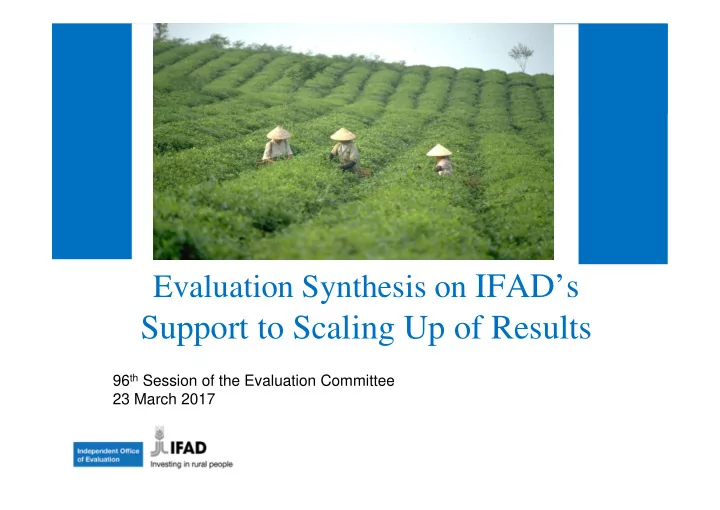

Evaluation Synthesis on IFAD’s Support to Scaling Up of Results 96 th Session of the Evaluation Committee 23 March 2017
Introduction • Definition (2015): “expanding, adapting and supporting successful policies, programmes and knowledge, so that they can leverage resources and partners to deliver larger results for a greater number of rural poor in a sustainable way”. • Key recent corporate documents concerning scaling up Brookings Review of IFAD’s Scaling Up Approach (2010) Operational Framework for Scaling Up of Results (2015) 2
Sources of this synthesis Review of: (i) Management documents; (ii) Independent evaluation reports and ARRI database Document content analysis and coding of findings Interviews with IFAD Management and staff; and comparator organizations (e.g., WB, IADB, UNDP, GIZ) E-survey of IFAD operational staff 3
IFAD 2015 Operational Framework for Scaling-up of results 4
The conceptualization and IFAD’s business model Full conceptualization of scaling up came with 2010 Review and 2015 Operational Framework – overall sound Informed by past evaluations and Brookings Review Helped IFAD lead international events and discussions Scalability not addressed explicitly (some interventions are not scale-neutral) IFAD’s project cycle and business model. Opportunities but also challenges Project design can be complicated When project implementation is slow and M&E is weak, information on performance and scalability comes late Non-lending activities are crucial but in the past limited resources 5
Scaling-up in COSOPs All the 35 COSOPs prepared since 2010 make reference to scaling up. Two have articulated a dedicated strategy. Good example: Vietnam COSOP 2012 Specification of desired scale (number of farmers, number and scale of public-private producers’ platforms) Identification of key actors (public, private) at the national and district/commune level. Requirements, for financial, policy and technical support and regular monitoring Costing of IFAD, public and private support 6
Scaling-up in Projects Half of CPEs and PPEs conducted since 2010 presented cases of scaling up Scaling up more likely to be observed where IFAD had a country office Country status (e.g., LIC, MIC) not clearly correlated with scaling-up But some opportunities may have been missed Projects with positive performance ratings but without scaling up evidence Factors enabling scaling up Government ownership: (i) institutions; (ii) support of like-minded individuals IFAD’s extended engagement through multiple phases Non-lending activities: (i) avoid working in isolation; (ii) need to prove it is worth scaling-up 7
Main Conclusions • Long scaling up journey, still “work in progress”. Improved clarity after 2010 Brookings Review and 2015 Operational Framework • Challenging elements in the IFAD project cycle: Complicated project design Delays in implementation and weak M&E In the past, limited emphasis on non-lending activities • Evaluations show good examples of scaling, along with some missed opportunities • Key enablers: Government ownership, IFAD’s long-term commitment, engagement in non-lending activities, country presence 8
Key Recommendations 1. Strengthen the country programme and project cycle to enhance scalability . Design: Scalability assessment (COSOP, project) on a more selective basis Implementation: monitor progress and scalability conditions Beyond project completion: non-lending activities and follow-up financing 2. Build stronger consensus and incentives in-house in support of scaling up 3. Set corporate targets based on achievements and evidence on scaling up pathway rather than “potential” 4. IOE to rate innovation and scaling up separately 9
Recommend
More recommend